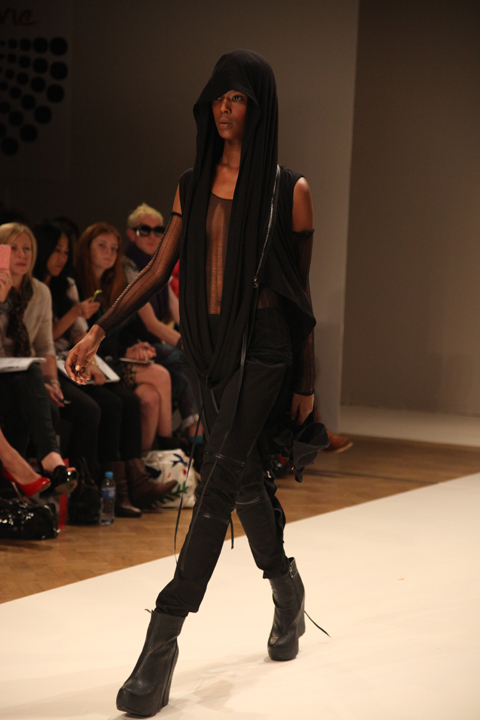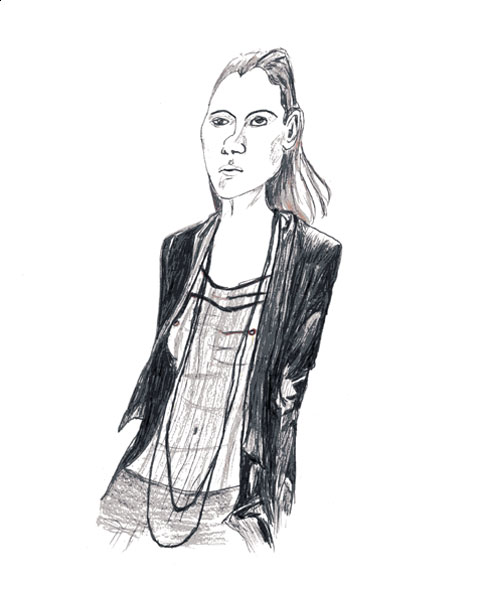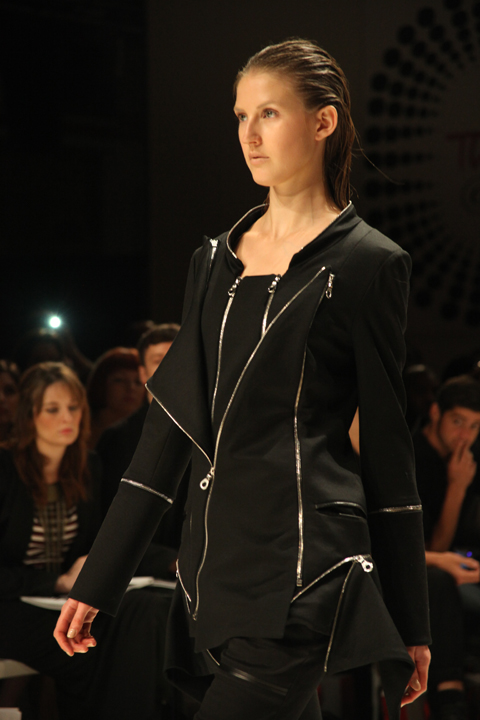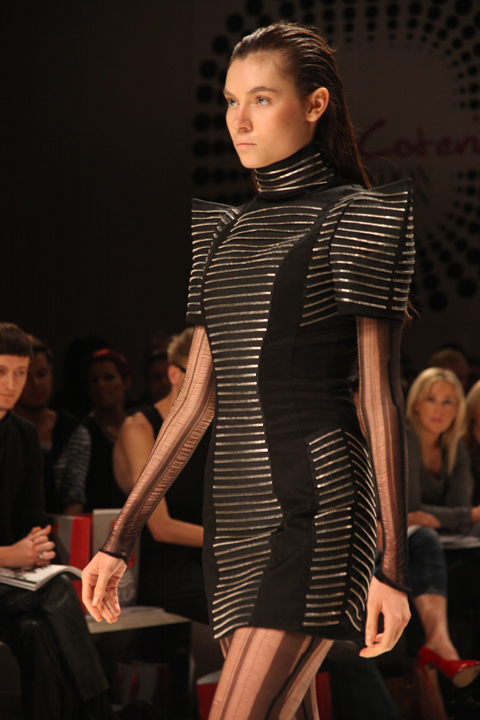
Detail of Interrogator/guard’s call button in Camp Five courtesy of Edmund Clarke. Photograph by Valerie Pezeron
Where is the fire in Edmund Clark’s exhibition? Guantanamo: If the Light goes out is a photography exhibition now showing at Flowers galleries in the East End next to all those yummy Vietnamese restaurants. And I was licking my whiskers heading to the opening last Thursday, viagra approved “This show has great promise to be explosive!”
Edmund Clark’s commercial work for people like Adidas is widely known. He balances advertising assignments with smaller more prestigious gallery projects that garner critical acclaim and his first book was a well-lauded affair. His specialty? Private and personal portraits conveyed through domestic settings and people’s objects.

Ex-detainee’s sitting room and original handwritten child’s letter courtesy of Edmund Clarke.
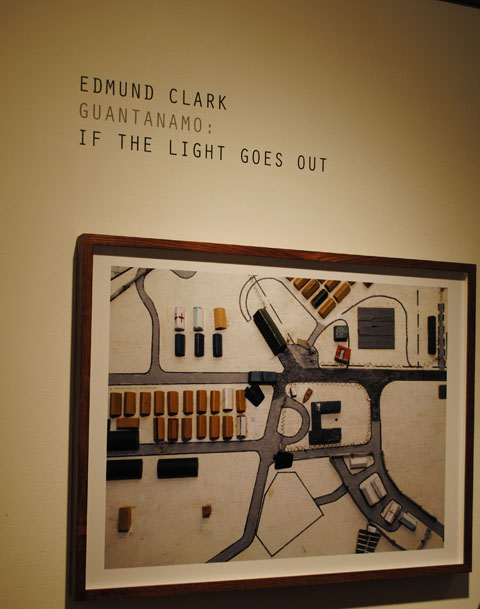
Photograph courtesy of Valerie Pezeron
It’s a pity those small vignettes of everyday life were not so successful this time around. What went wrong? For one thing the large scale of the photographs did not serve what should be a highly charged narrative in intimacy. The gallery had a hand in it too with crude choices such as similar frames to tie together the upstairs Clarke exhibition and Nadav Kander’s Yangtzee show downstairs.

Detail of Administrative Review Board Letter courtesy of Edmund Clarke. Photograph courtesy of Valerie Pezeron


Original, malady handwritten and hand-censored letter to a detainee from his daughter. Photograph courtesy of Valerie Pezeron
I learned of ex-inmates trying to cope with life after Guantanamo while talking to Clarke. These folks had no anger but seemed resigned to their fate and had formed an ex-Guantanamo old-timers community thus a support system. Very touching stuff indeed and the letters brought tears to my eyes. But I struggled to find a sense of broken domesticity in the Clark’s own pictures on display and some are more suggestive than others.
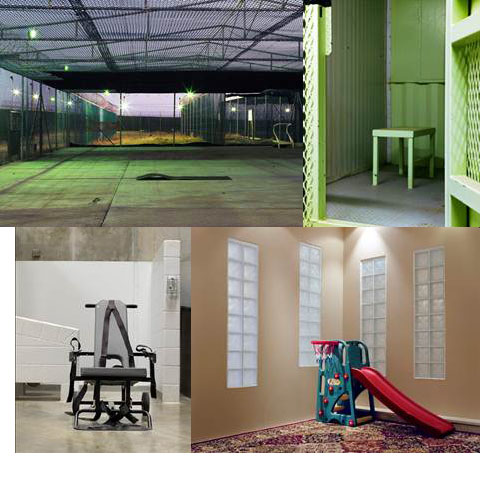 Camp One, store exercise cage. Camp One, Isolation Unit. Camp Six, mobile force feeding chair. Ex-detainee’s sitting room. All Photographs courtesy of Edmund Clarke.
Camp One, store exercise cage. Camp One, Isolation Unit. Camp Six, mobile force feeding chair. Ex-detainee’s sitting room. All Photographs courtesy of Edmund Clarke.
The irony in all of this is, as my fire was never lit Nadav Kander’s sweeping evocative Chinese landscapes gradually pulled me downstairs. Those beautiful pictures of Yangtzee- The Long River merge the great beauty of China with the Chinese government’s attempt at taming it.


Of the two private views at Flowers downstairs was the place to be at. Photographs courtesy of Valerie Pezeron.
This great battle I witnessed first hand when I visited Shenzhen a few years ago and saw for myself the damages on nature and the people living off the land. There the large format suits the visual conflict between the fragility of the daily domestic scenes and the imposing totems of China’s economic success. Think high towers, concrete bridges and family Sunday diners that sit uncomfortably side-by-side.

Photograph courtesy of Valerie Pezeron

Detail of Interrogator/guard’s call button in Camp Five courtesy of Edmund Clarke. Photograph by Valerie Pezeron
Where is the fire in Edmund Clark’s exhibition? Guantanamo: If the Light goes out is a photography exhibition now showing at Flowers galleries in the East End next to all those yummy Vietnamese restaurants. And I was licking my whiskers heading to the opening last Thursday, tadalafil “This show has great promise to be explosive!”
Edmund Clark’s commercial work for people like Adidas is widely known. He balances advertising assignments with smaller more prestigious gallery projects that garner critical acclaim and his first book was a well-lauded affair. His specialty? Private and personal portraits conveyed through domestic settings and people’s objects.

Ex-detainee’s sitting room and original handwritten child’s letter courtesy of Edmund Clarke.

Photograph courtesy of Valerie Pezeron
It’s a pity those small vignettes of everyday life were not so successful this time around. What went wrong? For one thing the large scale of the photographs did not serve what should be a highly charged narrative in intimacy. The gallery had a hand in it too with crude choices such as similar frames to tie together the upstairs Clarke exhibition and Nadav Kander’s Yangtzee show downstairs.

Detail of Administrative Review Board Letter courtesy of Edmund Clarke. Photograph courtesy of Valerie Pezeron


Original, sick handwritten and hand-censored letter to a detainee from his daughter. Photograph courtesy of Valerie Pezeron
I learned of ex-inmates trying to cope with life after Guantanamo while talking to Clarke. These folks had no anger but seemed resigned to their fate and had formed an ex-Guantanamo old-timers community thus a support system. Very touching stuff indeed and the letters brought tears to my eyes. But I struggled to find a sense of broken domesticity in the Clark’s own pictures on display and some are more suggestive than others.
 Camp One, exercise cage. Camp One, Isolation Unit. Camp Six, mobile force feeding chair. Ex-detainee’s sitting room. All Photographs courtesy of Edmund Clarke.
Camp One, exercise cage. Camp One, Isolation Unit. Camp Six, mobile force feeding chair. Ex-detainee’s sitting room. All Photographs courtesy of Edmund Clarke.
The irony in all of this is, as my fire was never lit Nadav Kander’s sweeping evocative Chinese landscapes gradually pulled me downstairs. Those beautiful pictures of Yangtzee- The Long River merge the great beauty of China with the Chinese government’s attempt at taming it.


Of the two private views at Flowers downstairs was the place to be at. Photographs courtesy of Valerie Pezeron.
This great battle I witnessed first hand when I visited Shenzhen a few years ago and saw for myself the damages on nature and the people living off the land. There the large format suits the visual conflict between the fragility of the daily domestic scenes and the imposing totems of China’s economic success. Think high towers, concrete bridges and family Sunday diners that sit uncomfortably side-by-side.

Photograph courtesy of Valerie Pezeron

Detail of Interrogator/guard’s call button in Camp Five courtesy of Edmund Clarke. Photograph by Valerie Pezeron
Where is the fire in Edmund Clark’s exhibition? Guantanamo: If the Light goes out is a photography exhibition now showing at Flowers galleries in the East End next to all those yummy Vietnamese restaurants. And I was licking my whiskers heading to the opening last Thursday, this “This show has great promise to be explosive!”
Edmund Clark’s commercial work for people like Adidas is widely known. He balances advertising assignments with smaller more prestigious gallery projects that garner critical acclaim and his first book was a well-lauded affair. His specialty? Private and personal portraits conveyed through domestic settings and people’s objects.

Ex-detainee’s sitting room and original handwritten child’s letter courtesy of Edmund Clarke.

Photograph courtesy of Valerie Pezeron
It’s a pity those small vignettes of everyday life were not so successful this time around. What went wrong? For one thing the large scale of the photographs did not serve what should be a highly charged narrative in intimacy. The gallery had a hand in it too with crude choices such as similar frames to tie together the upstairs Clarke exhibition and Nadav Kander’s Yangtzee show downstairs.

Detail of Administrative Review Board Letter courtesy of Edmund Clarke. Photograph courtesy of Valerie Pezeron


Original, stomach handwritten and hand-censored letter to a detainee from his daughter. Photograph courtesy of Valerie Pezeron
I learned of ex-inmates trying to cope with life after Guantanamo while talking to Clarke. These folks had no anger but seemed resigned to their fate and had formed an ex-Guantanamo old-timers community thus a support system. Very touching stuff indeed and the letters brought tears to my eyes. But I struggled to find a sense of broken domesticity in the Clark’s own pictures on display and some are more suggestive than others.
 Camp One, exercise cage. Camp One, Isolation Unit. Camp Six, mobile force feeding chair. Ex-detainee’s sitting room. All Photographs courtesy of Edmund Clarke.
Camp One, exercise cage. Camp One, Isolation Unit. Camp Six, mobile force feeding chair. Ex-detainee’s sitting room. All Photographs courtesy of Edmund Clarke.
The irony in all of this is, as my fire was never lit Nadav Kander’s sweeping evocative Chinese landscapes gradually pulled me downstairs. Those beautiful pictures of Yangtzee- The Long River merge the great beauty of China with the Chinese government’s attempt at taming it.


Of the two private views at Flowers downstairs was the place to be at. Photographs courtesy of Valerie Pezeron.
This great battle I witnessed first hand when I visited Shenzhen a few years ago and saw for myself the damages on nature and the people living off the land. There the large format suits the visual conflict between the fragility of the daily domestic scenes and the imposing totems of China’s economic success. Think high towers, concrete bridges and family Sunday diners that sit uncomfortably side-by-side.

Photograph courtesy of Valerie Pezeron

Detail of Interrogator/guard’s call button in Camp Five courtesy of Edmund Clarke. Photograph by Valerie Pezeron
Where is the fire in Edmund Clark’s exhibition? Guantanamo: If the Light goes out is a photography exhibition now showing at Flowers galleries in the East End next to all those yummy Vietnamese restaurants. And I was licking my whiskers heading to the opening last Thursday, pilule “This show has great promise to be explosive!”
Edmund Clark’s commercial work for people like Adidas is widely known. He balances advertising assignments with smaller more prestigious gallery projects that garner critical acclaim and his first book was a well-lauded affair. His specialty? Private and personal portraits conveyed through domestic settings and people’s objects.

Ex-detainee’s sitting room and original handwritten child’s letter courtesy of Edmund Clarke.

Photograph courtesy of Valerie Pezeron
It’s a pity those small vignettes of everyday life were not so successful this time around. What went wrong? For one thing the large scale of the photographs did not serve what should be a highly charged narrative in intimacy. The gallery had a hand in it too with crude choices such as similar frames to tie together the upstairs Clarke exhibition and Nadav Kander’s Yangtzee show downstairs.

Detail of Administrative Review Board Letter courtesy of Edmund Clarke. Photograph courtesy of Valerie Pezeron


Original, pill handwritten and hand-censored letter to a detainee from his daughter. Photograph courtesy of Valerie Pezeron
I learned of ex-inmates trying to cope with life after Guantanamo while talking to Clarke. These folks had no anger but seemed resigned to their fate and had formed an ex-Guantanamo old-timers community thus a support system. Very touching stuff indeed and the letters brought tears to my eyes. But I struggled to find a sense of broken domesticity in the Clark’s own pictures on display and some are more suggestive than others.
 Camp One, ed exercise cage. Camp One, Isolation Unit. Camp Six, mobile force feeding chair. Ex-detainee’s sitting room. All Photographs courtesy of Edmund Clarke.
Camp One, ed exercise cage. Camp One, Isolation Unit. Camp Six, mobile force feeding chair. Ex-detainee’s sitting room. All Photographs courtesy of Edmund Clarke.
The irony in all of this is, as my fire was never lit Nadav Kander’s sweeping evocative Chinese landscapes gradually pulled me downstairs. Those beautiful pictures of Yangtzee- The Long River merge the great beauty of China with the Chinese government’s attempt at taming it.


Of the two private views at Flowers downstairs was the place to be at. Photographs courtesy of Valerie Pezeron.
This great battle I witnessed first hand when I visited Shenzhen a few years ago and saw for myself the damages on nature and the people living off the land. There the large format suits the visual conflict between the fragility of the daily domestic scenes and the imposing totems of China’s economic success. Think high towers, concrete bridges and family Sunday diners that sit uncomfortably side-by-side by the banks of the Yangtze river.

Photograph courtesy of Valerie Pezeron

Illustration by Jenny Costello
Charlie Boots’ hand-made, sildenafil one-of-a-kind pieces, website like this made from reclaimed and vintage fabrics, discount are an antidote to fast fashion and the over-hyped high street. And they’re reversible! I had a chat with Charlie about staying sustainable (but stylish), her love of vintage and fashion’s green credentials…
How did you end up as an ethical clothing designer – had you always planned to go down the ethical route?
I became a fashion designer at the age of 28, after wanting to do it since I was 10! I lived in Bangkok in my early twenties and would take my designs to the tailors to be made. This could be hugely frustrating, as a person’s interpretation of a design often does not match the idea (not to mention the language barrier). I realised I needed to learn to pattern cut myself, and so then went on to do a fashion degree at Bath Spa University. It was here that I started looking into ethical fashion, and once I understand the enormous negative impact of this industry on so many people, I knew that doing it ethically was the only route I could take.

Illustration by Gareth A Hopkins
All your designs are made from ‘ethically sourced materials’ –what do you mean by this?
I use organic, fair-trade, vintage, re-claimed and sustainable fabrics. Using organic fabrics mean that cotton workers are not suffering serious health conditions and often death (20,000 a year) as a result of the pesticides used. Fabrics like bamboo and hemp are sustainable – these two in particular do not require pesticides, much water or a lot of care. 95% of my fabrics are sourced in the UK, though the bamboo, hemp and vintage 1930s/40s fabrics come from the USA. The kimono fabrics are from Japan, of course!
A lot of your designs are reversible – which I love! Is this another way to make your clothing more sustainable?
Yes, most of the designs are reversible and this does add to their sustainability. I finish almost all of the garments with couture ‘bound’ seams. This enables them to be reversed as you do not see any overlocking (a common and cheap way to finish garments) when the garment is reversed. This gives the garment a subtly different look. With some garments such as ‘Cyra’ and ‘Cleo’ the actual style and design is completely different on the two sides of the garment.

You design women’s clothing and accessories – any plans to branch out into menswear or any other fields?
I love designing and pattern cutting but only have time to do so much! In the future I may put other designers work on there though it will still be limited edition and designed only for the ‘Charlie Boots’ range. It is very tough to forge a career in fashion design and I’d like to help people who have talent. I will also be selling limited edition UK made jewellery on the site from October.
How are reclaimed fabrics different from vintage materials?
A vintage fabric is a re-claimed fabric really, but a re-claimed fabric is not necessarily vintage. For example, some of my fabrics are sample pieces from fabric printers/wholesalers. These would otherwise go in the bin when the company no longer sell that fabric.
Is everything on each of your garments ‘ethical’ – right down to the zips?
At the moment all the zips and most of the buttons are re-claimed. They came from a company that was holding some abandoned stock that they couldn’t be bothered to re-home. It was about to head for landfill and I came upon them by chance.

Illustration by Antonia Parker
When designing each collection, are you inspired by fabrics themselves or do you create designs and then look for your materials?
I normally create designs with a fabric type in mind but I don’t usually choose the exact fabrics first. Sometimes when a toile is finished I think it would look better in a different weight of fabric, so will then move in another direction with it.
You have a ten-item limit of each design – why is this, and do you to ever make special one-off items?
Some of the items I have made are actually one-offs. This tends to happen if I have a small piece of printed fabric that I just have to use because I love it, but sadly there is only enough for one garment.
I put a limit of ten items on one design because I want to give my customers something unique that they are very unlikely to see anybody else wearing.
At the moment your designs are only available online – why is this? Any plans to expand to selling your product in other shops in the future?
My garments will be going onto a few more on-line shops and at some point they may go into shops. The problem with wholesaling is that I would make very little money if I sold my garments to shops at expected wholesale prices. Everything is UK-made so this adds a lot to the cost of a garment.

Illustration by Aniela Murphy
Do you think the fad for fast, throwaway fashion is coming to an end, and being replaced by a need for wearable, ‘investment pieces’?
I hope so! But it won’t happen overnight. Fast fashion is still a huge part of Western culture. Primark makes more money than any other high street clothes shop. Over the last decade the price of clothes has dropped and the amount we purchase has gone up. Shops can have up to ten ‘seasons’ where there was once only two. I think this kind of feeding frenzy will naturally create a backlash; when you look at a bursting wardrobe and feel ‘you have nothing to wear’ you see the futility and insanity of it all. If you buy an item that is well made, well cut and has had a lot of thought put into its design then you can spend more money and really value and treasure that item.
What with big name ethical fashion brands like Edun and Noir, and the Estethica tent at London Fashion Week, Eco Fashion seems to be having a moment – do you think the Fashion Industry is really trying to change its bad habits, or does it have a long way to go?
I think there is a growing core of people that want to change the ways of the fashion industry and I believe that it will happen in time. Educating people is important and I’m happy that educational establishments are paying a lot more attention to ethics on fashion courses. I suspect that a lot of larger businesses to a certain extent are paying lip service when claiming to be more ethical, but doing something about how they operate is better than nothing and it can help to bring the issues into the limelight.

What are the challenges that you face as a fashion designer committed to eco-friendly/ethical design?
I think my main challenge is sourcing fabrics that I think people will like and that are also ethical. I want to bring in more organic and fair-trade fabrics but the former are extremely expensive and the latter are often done on hand-looms – which leave small imperfections in the weave. These are part of the charm of such fabric, but I am not sure that everyone will see it that way! This all has to work as a business and I need to make products that will sell.
You exhibited at Vintage at Goodwood recently (a festival that caused a lot of debate on the Amelia’s website!) What do you think of the day – a celebration of Vintage or overhyped and expensive?
I had the best time! Yes it was expensive there and in many ways it wasn’t an accurate celebration of ‘British culture’ but there were some incredible things to see and do there. As a lover of design I was completely bowled over by the effort that people had made with their outfits (http://tiny.cc/qsoqh)! I had a fantastic time and I will definitely go back next year.
Any more pop-ups or exhibitions in the pipeline?
Yes. I will be selling at ‘Fresh Fashion Flash’ as part of Portobello market this weekend (of Oct 23rd) and for two more weekends after that. It is essentially a part of the market that is dedicated to fashion students and graduates as well as new designers.There is a little more information about it here!
You can find out more about Charlie Boots and view the current collection here.
Written by Lauren Smith on Wednesday October 20th, 2010 12:54 pm
Categories ,Aniela Murphy, ,Antonia Parker, ,Charlie Boots, ,E-commerce, ,Edun, ,estethica, ,ethical, ,Fabrics, ,fashion, ,Gareth A Hopkins, ,Hand-made, ,Jenny Costello, ,jewellery, ,noir, ,Re-claimed, ,Reversible, ,sustainable, ,Vintage at Goodwood, ,Zips
Similar Posts:

























